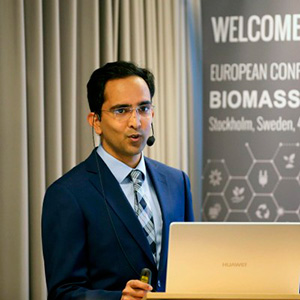
World - Biodiesel - Market Analysis, Forecast, Size, Trends And Insights
Get instant access to more than 2 million reports, dashboards, and datasets on the IndexBox Platform.
View PricingGrowing Algae for Biofuel
Algae are tiny aquatic organisms that can convert sunlight, water, and carbon dioxide into biomass. This biomass is rich in oils that can be converted into biofuels. Growing algae for biofuels is an exciting opportunity for many reasons. Firstly, algae grow rapidly and are capable of producing a high yield of biomass per square meter compared to traditional biofuels like corn, sugar cane, and soybeans. Secondly, algae can be grown in many types of water, including wastewater, saltwater, and freshwater. This makes algae cultivation a viable strategy for countries facing water scarcity issues. Thirdly, algae-based biofuels have a smaller carbon footprint compared to traditional fossil fuels, which means they can contribute significantly to reducing greenhouse gas emissions on a global scale.
The process of growing algae for biofuels involves several steps. The first step is selecting the right strain of algae that produces high quantities of oil. The next step is designing a system for cultivating algae at scale. There are three main types of systems used for algae cultivation: open ponds, photobioreactors, and hybrid systems. Open ponds are the simplest and most cost-effective solution for small-scale algae production, but they are not efficient for large-scale production. Photobioreactors, on the other hand, are a closed system where algae are grown in transparent containers that allow sunlight to enter. Hybrid systems combine the best features of open ponds and photobioreactors and are suitable for large-scale algae production.
Once the cultivation system is in place, the next step is to optimize the growth conditions for the algae. Factors like temperature, light, nutrients, and pH can significantly affect the growth rate and oil content of algae. Achieving optimal growth conditions can take time and effort, but it is crucial to get the best possible yield from the algae. Algae are harvested using a variety of methods, including mechanical harvesting and flocculation. The harvested algae are then processed to extract the oil, which can be converted into biofuels using different methods such as transesterification.
Growing algae for biofuels has its challenges, and one of the most significant challenges is the cost of production. Algae cultivation requires a considerable investment in infrastructure and technology, and this can make it difficult for small companies to compete with established biofuels. However, research and development in the field is ongoing, and many companies are finding innovative ways to reduce the production cost of algae-based biofuels.
In conclusion, growing algae for biofuels is a promising solution to the energy and environmental challenges facing the world today. With the right cultivation system and growth conditions, algae can produce a high yield of oil for biofuels in a sustainable and eco-friendly manner. Though currently more expensive than traditional fossil fuels and some other biofuels, algae-based biofuels offer the potential to revolutionize the energy industry while significantly reducing greenhouse gas emissions and providing new opportunities in the energy sector.
This report provides an in-depth analysis of the global biodiesel market. Within it, you will discover the latest data on market trends and opportunities by country, consumption, production and price developments, as well as the global trade (imports and exports). The forecast exhibits the market prospects through 2030.
Product coverage:
- Prodcom 20595997 - Biofuels (diesel substitute)
Country coverage:
Worldwide - the report contains statistical data for 200 countries and includes detailed profiles of the 50 largest consuming countries:
- USA
- China
- Japan
- Germany
- United Kingdom
- France
- Brazil
- Italy
- Russian Federation
- India
- Canada
- Australia
- Republic of Korea
- Spain
- Mexico
- Indonesia
- Netherlands
- Turkey
- Saudi Arabia
- Switzerland
- Sweden
- Nigeria
- Poland
- Belgium
- Argentina
- Norway
- Austria
- Thailand
- United Arab Emirates
- Colombia
- Denmark
- South Africa
- Malaysia
- Israel
- Singapore
- Egypt
- Philippines
- Finland
- Chile
- Ireland
- Pakistan
- Greece
- Portugal
- Kazakhstan
- Algeria
- Czech Republic
- Qatar
- Peru
- Romania
- Vietnam
+ the largest producing countries
Data coverage:
- Global market volume and value
- Per Capita consumption
- Forecast of the market dynamics in the medium term
- Global production, split by region and country
- Global trade (exports and imports)
- Export and import prices
- Market trends, drivers and restraints
- Key market players and their profiles
Company coverage:
Reasons to buy this report:
- Take advantage of the latest data
- Find deeper insights into current market developments
- Discover vital success factors affecting the market
This report is designed for manufacturers, distributors, importers, and wholesalers, as well as for investors, consultants and advisors.
In this report, you can find information that helps you to make informed decisions on the following issues:
- How to diversify your business and benefit from new market opportunities
- How to load your idle production capacity
- How to boost your sales on overseas markets
- How to increase your profit margins
- How to make your supply chain more sustainable
- How to reduce your production and supply chain costs
- How to outsource production to other countries
- How to prepare your business for global expansion
While doing this research, we combine the accumulated expertise of our analysts and the capabilities of artificial intelligence. The AI-based platform, developed by our data scientists, constitutes the key working tool for business analysts, empowering them to discover deep insights and ideas from the marketing data.
-
1. INTRODUCTION
Making Data-Driven Decisions to Grow Your Business
- REPORT DESCRIPTION
- RESEARCH METHODOLOGY AND AI PLATFORM
- DATA-DRIVEN DECISIONS FOR YOUR BUSINESS
- GLOSSARY AND SPECIFIC TERMS
-
2. EXECUTIVE SUMMARY
A Quick Overview of Market Performance
- KEY FINDINGS
- MARKET TRENDS This Chapter is Available Only for the Professional Edition PRO
-
3. MARKET OVERVIEW
Understanding the Current State of The Market and Its Prospects
- MARKET SIZE
- CONSUMPTION BY COUNTRY
- MARKET FORECAST TO 2030
-
4. MOST PROMISING PRODUCT
Finding New Products to Diversify Your Business
This Chapter is Available Only for the Professional Edition PRO- TOP PRODUCTS TO DIVERSIFY YOUR BUSINESS
- BEST-SELLING PRODUCTS
- MOST CONSUMED PRODUCT
- MOST TRADED PRODUCT
- MOST PROFITABLE PRODUCT FOR EXPORT
-
5. MOST PROMISING SUPPLYING COUNTRIES
Choosing the Best Countries to Establish Your Sustainable Supply Chain
This Chapter is Available Only for the Professional Edition PRO- TOP COUNTRIES TO SOURCE YOUR PRODUCT
- TOP PRODUCING COUNTRIES
- TOP EXPORTING COUNTRIES
- LOW-COST EXPORTING COUNTRIES
-
6. MOST PROMISING OVERSEAS MARKETS
Choosing the Best Countries to Boost Your Exports
This Chapter is Available Only for the Professional Edition PRO- TOP OVERSEAS MARKETS FOR EXPORTING YOUR PRODUCT
- TOP CONSUMING MARKETS
- UNSATURATED MARKETS
- TOP IMPORTING MARKETS
- MOST PROFITABLE MARKETS
7. GLOBAL PRODUCTION
The Latest Trends and Insights into The Industry
- PRODUCTION VOLUME AND VALUE
- PRODUCTION BY COUNTRY
8. GLOBAL IMPORTS
The Largest Importers on The Market and How They Succeed
- IMPORTS FROM 2012–2023
- IMPORTS BY COUNTRY
- IMPORT PRICES BY COUNTRY
9. GLOBAL EXPORTS
The Largest Exporters on The Market and How They Succeed
- EXPORTS FROM 2012–2023
- EXPORTS BY COUNTRY
- EXPORT PRICES BY COUNTRY
-
10. PROFILES OF MAJOR PRODUCERS
The Largest Producers on The Market and Their Profiles
This Chapter is Available Only for the Professional Edition PRO -
11. COUNTRY PROFILES
The Largest Markets And Their Profiles
This Chapter is Available Only for the Professional Edition PRO- United States
- China
- Japan
- Germany
- United Kingdom
- France
- Brazil
- Italy
- Russian Federation
- India
- Canada
- Australia
- Republic of Korea
- Spain
- Mexico
- Indonesia
- Netherlands
- Turkey
- Saudi Arabia
- Switzerland
- Sweden
- Nigeria
- Poland
- Belgium
- Argentina
- Norway
- Austria
- Thailand
- United Arab Emirates
- Colombia
- Denmark
- South Africa
- Malaysia
- Israel
- Singapore
- Egypt
- Philippines
- Finland
- Chile
- Ireland
- Pakistan
- Greece
- Portugal
- Kazakhstan
- Algeria
- Czech Republic
- Qatar
- Peru
- Romania
- Vietnam
-
LIST OF TABLES
- Key Findings In 2023
- Market Volume, In Physical Terms, 2012–2023
- Market Value, 2012–2023
- Per Capita Consumption, By Country, 2018–2023
- Production, In Physical Terms, By Country, 2012–2023
- Imports, In Physical Terms, By Country, 2012–2023
- Imports, In Value Terms, By Country, 2012–2023
- Import Prices, By Country Of Destination, 2012–2023
- Exports, In Physical Terms, By Country, 2012–2023
- Exports, In Value Terms, By Country, 2012–2023
- Export Prices, By Country Of Origin, 2012–2023
-
LIST OF FIGURES
- Market Volume, In Physical Terms, 2012–2023
- Market Value, 2012–2023
- Consumption, By Country, 2023
- Market Volume Forecast to 2030
- Market Value Forecast to 2030
- Products: Market Size And Growth, By Type
- Products: Average Per Capita Consumption, By Type
- Products: Exports And Growth, By Type
- Products: Export Prices And Growth, By Type
- Production Volume And Growth
- Exports And Growth
- Export Prices And Growth
- Market Size And Growth
- Per Capita Consumption
- Imports And Growth
- Import Prices
- Production, In Physical Terms, 2012–2023
- Production, In Value Terms, 2012–2023
- Production, By Country, 2023
- Production, In Physical Terms, By Country, 2012–2023
- Imports, In Physical Terms, 2012–2023
- Imports, In Value Terms, 2012–2023
- Imports, In Physical Terms, By Country, 2023
- Imports, In Physical Terms, By Country, 2012–2023
- Imports, In Value Terms, By Country, 2012–2023
- Import Prices, By Country, 2012–2023
- Exports, In Physical Terms, 2012–2023
- Exports, In Value Terms, 2012–2023
- Exports, In Physical Terms, By Country, 2023
- Exports, In Physical Terms, By Country, 2012–2023
- Exports, In Value Terms, By Country, 2012–2023
- Export Prices, 2012–2023
Explore the top import markets for biodiesel globally and understand the key statistics and trends. Discover the countries leading the biodiesel import market and their import values as per the IndexBox market intelligence platform.
Discover the top import markets for biodiesel and how these countries are driving the growth of the industry. Learn why the Netherlands, Belgium, France, Germany, and Spain are leading the way in biodiesel imports.
This year, Belgium is overtaking Germany to emerge as the second-largest biodiesel exporter in the world. From January to July 2021, Belgium supplied biodiesel worth $2.1B abroad, while Germany’s exports were estimated at $1.8B. The Netherlands keeps the leading position with a biodiesel export value of $4.2B. In 2020, Germany ($2.3B) followed the Netherlands ($4.6B) in global export ranking, while Belgium ($1.5B) took third place. The average biodiesel export price grew by +11% y-o-y to $979 per ton in 2020.
Neither the pandemic nor the low oil prices succeeded in slowing the growth of the global biodiesel market. As economies worldwide start to recover from the Covid crisis, and environmental concerns increase, the demand is set to remain robust in 2021.











































